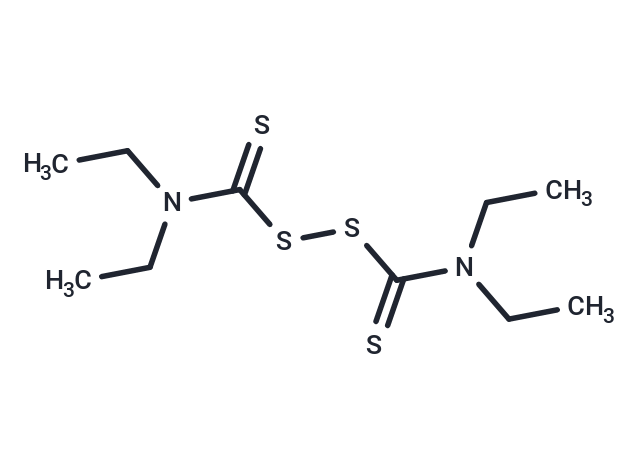Shopping Cart
- Remove All
 Your shopping cart is currently empty
Your shopping cart is currently empty

Disulfiram (TETD) is an inhibitor of the acetaldehyde dehydrogenase ALDH, inhibiting hALDH1 and hALDH2 (IC50=0.15/1.45 μM) with specificity. Disulfiram is acutely sensitized to alcohol and also inhibits GSDMD pore formation.

| Pack Size | Price | Availability | Quantity |
|---|---|---|---|
| 1 g | $50 | In Stock | |
| 1 mL x 10 mM (in DMSO) | $50 | In Stock |
| Description | Disulfiram (TETD) is an inhibitor of the acetaldehyde dehydrogenase ALDH, inhibiting hALDH1 and hALDH2 (IC50=0.15/1.45 μM) with specificity. Disulfiram is acutely sensitized to alcohol and also inhibits GSDMD pore formation. |
| In vitro | Disulfiram inhibits the P-glycoprotein efflux pump, suppresses the transcription factor NF-κB (nuclear factor-κB), reduces angiogenesis, and inhibits tumor growth in mice. Its antitumor activity is associated with in vivo protease inhibition. Disulfiram also induces apoptosis. In severe combined immunodeficient mice with melanoma xenografts, it impedes growth and angiogenesis, an effect that is enhanced by zinc supplementation. |
| In vivo | Disulfiram, clinically employed as an anti-alcoholism agent, potently inhibits both constitutive and 5-FU-induced NF-κB activity in a dose-dependent manner. In the DLD-1 and RKO (WT) cell lines, Disulfiram significantly augments the apoptotic effects of 5-FU and synergistically enhances its cytotoxicity. In melanoma cells, co-treatment with copper or zinc ions reduces cyclin A expression compared to Disulfiram alone and inhibits proliferation in vitro. Moreover, Disulfiram decreases viable cell count, with copper chloride addition markedly intensifying DSF-induced cell death. |
| Cell Research | The effect of disulfiram (0.15-5.0 μM) or sodium diethyldithiocarbamate (1.0 μM) on proliferation of malignant cell lines is studied in cultures stimulated with 10% FBS. Cell numbers are quantitated 24 to 72 hours later, as outlined below. In some experiments, disulfiram is added immediately after cells are plated. In other experiments, cells are plated and allowed to grow for 24 to 72 hours before fresh medium with disulfiram is added and cell numbers are assayed 24 to 72 hours later. Synergy is studied between disulfiram and?N,N′-bis(2-chloroethyl-N-nitrosourea (carmustine, 1.0-1,000 μM) or cisplatin (0.1-100 μg/mL) added to medium. The effect of metal ions on disulfiram is studied with 0.2 to 10 μM Cu2+?(provided as CuSO4), Zn2+?(as ZnCl2), Ag+?(as silver lactate), or Au3+?(as HAuCl4·3Water) ions added to growth medium, buffered to physiologic pH. To provide a biologically relevant source of copper, medium is supplemented with human ceruloplasmin at doses replicating low and high normal adult serum concentrations (250 and 500 mg/mL). |
| Alias | Tetraethylthiuram disulfide, TETD, NSC 190940 |
| Molecular Weight | 296.54 |
| Formula | C10H20N2S4 |
| Cas No. | 97-77-8 |
| Smiles | CCN(CC)C(=S)SSC(=S)N(CC)CC |
| Relative Density. | 1.27 g/cm3 |
| Storage | Powder: -20°C for 3 years | In solvent: -80°C for 1 year | Shipping with blue ice. | ||||||||||||||||||||
| Solubility Information | 20% Cremophor EL+80% Saline: 10 mg/mL (33.72 mM), In vivo: Please add co-solvents sequentially, clarifying the solution as much as possible before adding the next one. Dissolve by heating and/or sonication if necessary. Working solution is recommended to be prepared and used immediately. DMSO: 20 mg/mL (67.44 mM), Sonication is recommended. Ethanol: 29.7 mg/mL (100.16 mM), Sonication is recommended. 10% DMSO+40% PEG300+5% Tween 80+45% Saline: 2.97 mg/mL (10.02 mM), In vivo: Please add the solvents sequentially, clarifying the solution as much as possible before adding the next one. Dissolve by heating and/or sonication if necessary. Working solution is recommended to be prepared and used immediately. | ||||||||||||||||||||
Solution Preparation Table | |||||||||||||||||||||
DMSO/Ethanol
Ethanol
| |||||||||||||||||||||

Copyright © 2015-2025 TargetMol Chemicals Inc. All Rights Reserved.